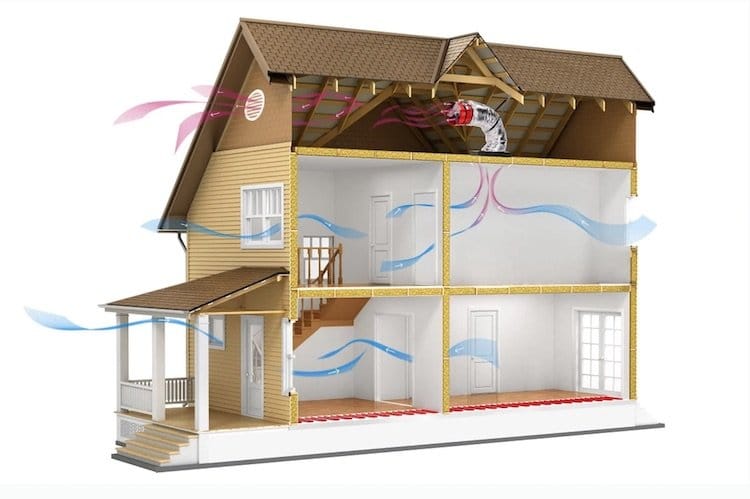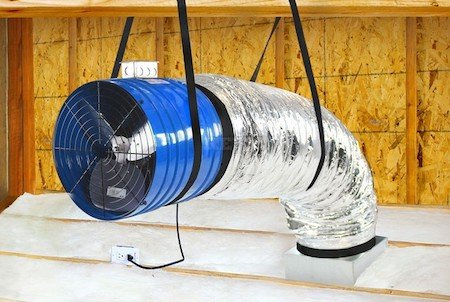Your trusted home service experts
What Is A Whole House Fan?

A whole house fan is a cooling system that circulates air and provides good attic ventilation and cooling for an entire property. A whole house fan system is installed in the ceiling between the attic and living space. There are two types of whole house fans. The difference between the two is the maximum amount of desired airflow, ranging between 1,000 and 3,000 cubic feet per minute (cfm). The larger fans will give you a breeze, while the smaller fans will provide a more moderate airflow throughout the house.
Whole House Fan vs Attic Fan

Whole house fans and attic fans are often confused. However, they are not the same thing.
- Attic Fans – ventilate only the attic to reduce heat buildup and operate year-round
- Whole House Fans – ventilate the whole house, including the attic and living space by bringing cool air from outside into the house to cool it and force the hot air out through the attic vents. They typically only operate during one or two seasons each year.

Whole House Fan vs Central Air and Window Units
Whole House Fans should never be used simultaneously with air conditioning of any kind – central air or window units. These systems can both reside in the same home and be used to complement one another, but they are more relay partners than three-legged-race partners.
- Whole House Fans should never be used simultaneously with air conditioning of any kind – central air or window units. These systems can both reside in the same home and be used to complement one another, but they are more relay partners than three-legged-race partners.
- Central Air Conditioning – cools the air with a chemical (like Freon) and circulates it within the house but does not pull in fresh air from the outside
- Window AC Units – pull outside air and cools it with a chemical (like Freon)
- Whole House Fans
- Pull cool outside air into the house to cool it, then push the hot air in the house out through the attic
- Use 90% less energy to do it than an air conditioning system
- Can be used as a cheaper substitute for AC
- Are more environmentally friendly and do not release harmful toxins into the air.
Whole House Fan vs Ceiling Fans
- Ceiling Fans – just move air around; they don’t pull in fresh or cooler air
- Whole House Fans – Can improve the indoor air quality by filtering in fresh air and filtering out polluted air
How to Use a Whole House Fan
Just how does a whole house fan work? The fan is installed in a central location (like a main hallway) on the top floor or attic. Take these steps to operate your system:
- Once it is operational, crack or open the windows in the rooms you want to cool (only open a few for optimum whole house fan effectiveness) and shut the windows in the rooms you may not occupy or need quite as cool in order to create ideal airflow.
- Turn on the fan — typically a manual process to avoid forgetting to open the windows and creating a backdraft.
- The whole house fan then draws cool air from outside in through open windows/doors, and pushes the hot air from inside the house outside through existing vents on the roof, effectively cooling your home.
- Once the house reaches the desired temperature or the outside temperatures start to rise, close the windows to keep the room cool into the day.
Pro Tip: Close fireplace dampers to prevent soot being pulled into the house. When used properly, these fans provide a number of benefits.
How to Use a Whole House Fan Effectively – Do’s and Don’ts
Do whole house fans work? Just follow the steps above for proper operation and keep these few things in mind too.
Take These Steps:
- Ask the technician installing your whole house fan how many windows need to be open in order to safely run it so you don’t create a backdraft or pull in polluted air
- Cover and seal your whole house fan during the winter to prevent heat loss and higher energy bills
Things to Avoid:
- Use it on days with high humidity
- Operate a whole house fan and the air conditioner at the same time
When Should I Run My Whole House Fan?
The best time to run your whole house fan is when the air is coolest (i.e. at night) and dry or when the temperature outside matches the desired inside temperature.
Whole House Fan Sizing

The first step in a whole house fan installation is to choose the right size for your home. If it’s too small, the system will not be effective. If it is too large, the whole house fan will use more energy and potentially be noisier than necessary.
To determine sizing, you have to consider three things:
- The square footage of your house (excluding the basement)
- The desired cooling effect (Do you want a breeze or a more moderate airflow?)
- Does your attic have a gas heater/furnace with a standing pilot light? If so, you cannot install the whole house fan; it is a fire hazard.

How to Install a Whole House Fan
Once you have selected a fan and have an electrician in place, the actual installation begins with these steps:
- The fan must be installed on the top floor or in the attic near a window or door or installed directly in the attic roof.
- An electrician will equip your house with the proper wiring or make sure it already exists.
- Proper ventilation will be added. The US Department of Energy notes that you need 2 to 4 times the normal area of attic vents to avoid pulling dangerous things like carbon monoxide into your living space. You may be able to use your existing HVAC ducts to do this, but it would involve installing an intake duct.
Have questions about whole house fans? Contact our experienced team of electrical contractors to find the answers!
St. Louis
Explore the services we
offer at our St. Louis Location!
-
(314) 664-3011
-
1025 Hanley Industrial
Brentwood, MO 63144
Nashville
Explore the services we
offer at our Nashville Location!
-
(615) 515-3015
-
45 Willow St
Nashville, TN 37210



